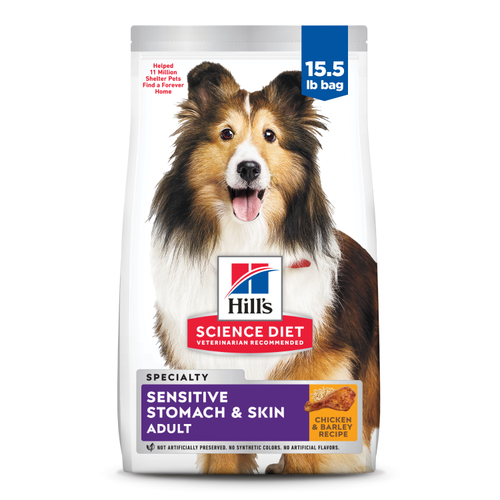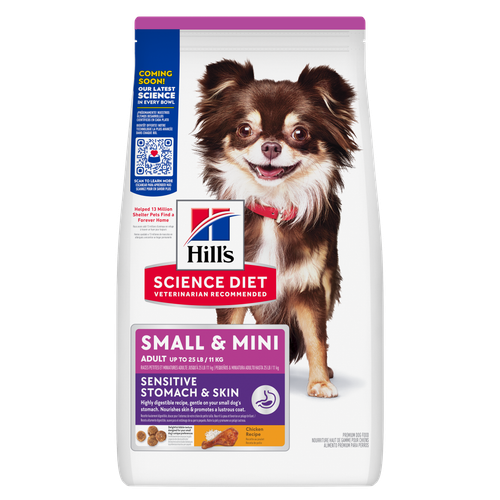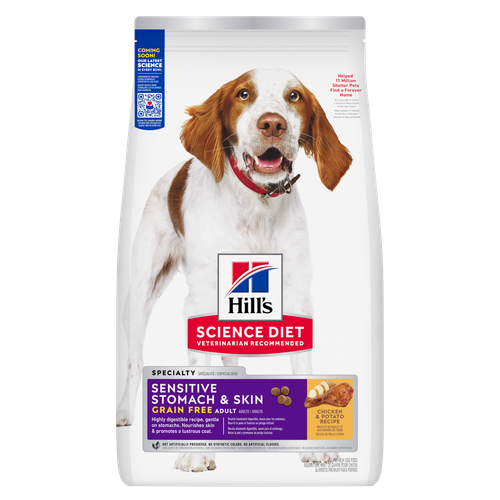
-
Find the right food for your petTake this quiz to see which food may be the best for your furry friend.Find the right food for your petTake this quiz to see which food may be the best for your furry friend.Featured products
 Adult Large Breed Chicken & Barley Recipe Dog Food
Adult Large Breed Chicken & Barley Recipe Dog FoodSupports healthy joints, lean muscle, and beautiful coat for large breed dogs
Shop Now Adult Chicken & Barley Recipe Dog Food
Adult Chicken & Barley Recipe Dog FoodSupports lean muscle and beautiful coat for adult dogs
Shop Now Hill's Science Diet Adult Chicken & Beef Entrée Dog Food
Hill's Science Diet Adult Chicken & Beef Entrée Dog FoodChicken & Beef Entrée in a delicious loaf with complete & balanced nutrition to help keep adult dogs active and healthy
Shop NowFeatured products Adult Tender No Corn, Wheat, Soy Chicken & Vegetables Stew Cat FoodShop Now
Adult Tender No Corn, Wheat, Soy Chicken & Vegetables Stew Cat FoodShop Now Adult Turkey & Liver Entrée Cat Food
Adult Turkey & Liver Entrée Cat FoodPrecisely balanced nutrition with the delicious taste of minced turkey & liver to help fuel the energy needs of cats during the prime of their life
Shop Now Senior Vitality Adult 7+ Tuna & Vegetables Stew
Senior Vitality Adult 7+ Tuna & Vegetables StewImproves Everyday Ability to Get Up & Go
Shop Now -
Dog
- Dog Tips & Articles
-
Health Category
- Weight
- Food & Environmental Sensitivities
- Urinary
- Digestive
- Joint
- Kidney
-
Life Stage
- Puppy Nutrition
- Adult Nutrition
- Senior Nutrition
Cat- Cat Tips & Articles
-
Health Category
- Weight
- Skin & Food Sensitivities
- Urinary
- Digestive
- Kidney
-
Life Stage
- Kitten Nutrition
- Adult Nutrition
Featured articles What Is Littermate Syndrome? Pet Adoption Guide
What Is Littermate Syndrome? Pet Adoption GuideLearn more about littermate syndrome in dogs and cats and how to successfully navigate adoption and early socialization processes.
Read More The Science Behind Our Love for Pets
The Science Behind Our Love for PetsLearn the scientific reasons why we have such strong connections with our pets, and what science says about the love between humans and our furry friends.
Read More How to Properly Mix Wet & Dry Pet Foods
How to Properly Mix Wet & Dry Pet FoodsAn Orange cat eating from a bowl filled with mixed food
Read More -


If you come home and your pooch doesn't greet you as usual or if the place looks like it's been hit by a tornado, you might think that your dog is mad at you for leaving. Here's what you need to know about dogs and anger, and how to tell if your dog is upset.
Dogs and Anger

It turns out that the question of whether your dog is mad at you or not is the wrong question to ask. While dogs can indeed get upset by a situation, they don't get mad at someone in the same way that you do. According to HealthyPsych, anger is what psychologists refer to as a secondary emotion, which is a human response to primary emotions like fear and sadness. Anger is too complex a feeling for dogs to truly experience; however, dogs are capable of experiencing the more basic emotions that humans use anger to hide.
Dogs also don't assign blame in the way that humans do, says Cuteness. While your dog might make associations between an object or a situation and the feelings they inspire — for example, a puppy might trip down steps and get hurt while carrying a toy and then associate the toy with something harmful — they don't actually think about it being the object's fault. It simply doesn't occur to your pooch to blame you for what's making them unhappy.
Signs That Your Dog Is Upset
Your dog may try to communicate that they're upset in ways that make them seem angry with you. But more likely than not, they're simply trying to convey their feelings and looking to you to stop the source of their distress.
Here are common dog behaviors that are often mistakenly interpreted as anger toward a pet parent.
Chewing Furniture
What it might mean: Rather than an attempt to get revenge, your dog is probably bored and making a desperate attempt at amusement in the absence of company or other entertainment.
What you should do: Make sure to provide your pup with toys when you leave them alone. The best kind of toy is interactive, like a puzzle or treat-dispensing toy. Leaving the radio or TV on can also help your pup feel less lonely. A video or voice recording of yourself is even better.
Growling or Snarling
What it might mean: Growling is usually your dog's way of letting you know that something is upsetting them, and they want it to stop, according to Reader's Digest. Dogs growl for various reasons that have nothing to do with anger, such as resource guarding. You'll be able to tell if this is the cause if they growl over food or a toy that they fear you or another animal might take from them. Similarly, you might hear a growl if you make them move from a comfortable spot.
What you should do: Don't punish or yell at your dog for growling. Doing so could make the behavior worse or frighten them into snapping or biting. Instead, stay calm and ignore the behavior. If you need to take something away from a resource-guarding dog, try to distract them with a treat while you remove the object, suggests iHeartDogs. Watch for other signs of aggression, such as showing the whites of their eyes, flattened ears, repetitive lip licking or bared teeth. If you see any of these signs, leave your dog alone and wait for them to lose interest in the object. Otherwise, you risk getting bitten.


Tasty Tips
Peeing on Your Things
What it might mean: While you may think your dog peed on the pile of laundry you left on the floor out of spite, the truth is there are a number of reasons dogs might pee on your stuff. According to The Nest, one reason dogs pee on their pet parents' things is to mark their territory. It could also mean that you didn't let them out soon enough when they needed to go to the bathroom. If this behavior mostly happens when your dog is home alone, it could be a sign of separation anxiety. And if your dog is housebroken but often has accidents on soft places, like piles of clothing, it could signal a health problem such as a urinary tract infection or urinary incontinence.
What you should do: If you think a medical issue or separation anxiety might be causing this behavior, consult your veterinarian. Otherwise, keep in mind that your dog's bladder doesn't always operate on your preferred schedule and be sure to pay attention when they let you know that they need to go. If your schedule prevents you from being able to attend to your dog's needs right away, you might consider a dog walker or doggy door to continue to train them that the best place to relieve themselves is outside. Using dog training pads near the spots where they tend to sneak off for a potty break should be considered a last resort to they don't associate going indoors as an acceptable behavior. And avoid leaving dirty laundry or other items you don't want to get peed on in areas accessible to your dog.
Avoiding You
What it might mean: If your pooch is avoiding you, it probably means that they're stressed out for some reason, and they need time alone to cope. Hiding can also signal that your dog is in pain.
What you should do: First, don't take it personally. Remember that your dog isn't actually angry at you. It's possible your pup is picking up on your own bad mood and it's causing them stress. It could also be something innocuous, like the smell of your perfume or hair product. Or, if you've been playing with them or teasing them, they might be frustrated or overstimulated and need space to calm down. In any case, it's best to give them their space and, in the meantime, check yourself to make sure you're not giving off an upsetting vibe or that you haven't pushed your dog too far. Give them the chance to chill out and return to you when they feel ready.
If you notice that your dog is in pain for any reason, it is best to get them to the veterinarian as soon as you can.
Instead of wondering if your dog is mad at you the next time they act out, you'll know how to respond and help them relax. Knowing how to better read your dog's behavior will only serve to strengthen your bond.


Jean Marie Bauhaus is a pet parent, pet blogger, and novelist from Tulsa, Oklahoma, where she usually writes under the supervision of a lapful of fur babies.
Related products

Highly digestible recipe, gentle on stomachs. Nourishes skin & promotes a lustrous coat

Hill's Science Diet Sensitive Stomach & Skin Small & Mini dry dog food is tailored nutrition for Small & Mini dogs while being gentle on stomachs. Nourishes skin & promotes a lustrous coat.

Hill's Science Diet Sensitive Stomach & Skin Grain Free dry dog food is gentle on stomachs. Nourishes skin & promotes a lustrous coat.

Over 70% of dogs lost weight within 10 weeks when fed this nutrition (USA Study)
Related articles

Wondering where can I buy a dog? Consider adoption and explore the pros and cons of adopting a dog from a breeder versus an animal shelter.

Learn how to help keep your dog's immune system in tip-top shape, including nutritional immune system support for dogs and other strategies.

Your dog's coat and skin are a big part of your dog's overall health. Ensure you keep your dog's coat healthy, by following these simple tips.

Discover how the field of dog science is giving us more and more insights into the inner workings of our furry best friends.

Put your dog on a diet without them knowing
Our low calorie formula helps you control your dog's weight. It's packed with high-quality protein for building lean muscles, and made with purposeful ingredients for a flavorful, nutritious meal. Clinically proven antioxidants, Vitamin C+E, help promote a healthy immune system.
Put your dog on a diet without them knowing
Our low calorie formula helps you control your dog's weight. It's packed with high-quality protein for building lean muscles, and made with purposeful ingredients for a flavorful, nutritious meal. Clinically proven antioxidants, Vitamin C+E, help promote a healthy immune system.

